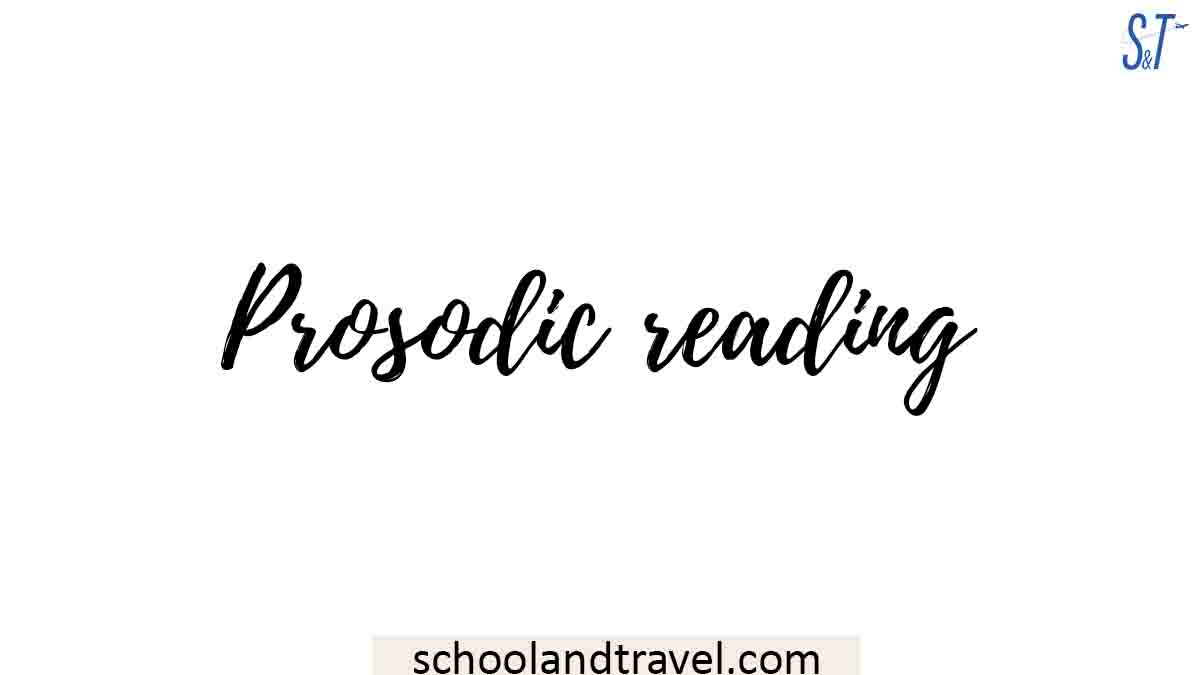Prosodic reading, or reading fluency, is considered one of the hallmarks of fluent reading.
When a child is reading prosodically, oral reading sounds like speech with proper phrasing, pause structures, stress, rise and fall patterns, and all-around expressiveness.
However, where does the improvement of prosodic reading or “making it sound like language” suit our conceptions of growing reading ability?
This article explains the basic concept of prosodic reading, importance, improvement and many more.
What is Prosodic reading?
Despite its presumed reputation as the hallmark of fluent reading, we currently know little about the way of prosodic reading.
Prosodic reading is the method of studying to read fluently.
To read prosodically, children must do more than decode text and translate punctuation into speech.
They ought to also include the normal rise and fall of pitch in normal conversation.
This could be a collection of speech qualities that the listener interprets as an emotive depiction of textual content.
To research prosodic reading, one must convert oral reading speech sound waves into a visible depiction known as a spectrogram, where the waves may be evaluated more or less directly.
Characteristics essential to Prosodic Reading:
Here are the characteristics that are essential to prosodic reading
- Modifications in pitch
- Stress or loudness
- Period and pausing
Pauses both inside sentences (intra-sentential) and among sentences (inter-sentential) may be recognized objectively by demarking and measuring factors of silence.
Fluent readers use prosody (pitch, stress, and timing) to show meaning when they read aloud.
Non-fluent readers tend to read with less expression, reading word by word rather than in phrases or chunks, and without using tone or pausing to recognize punctuation (e.g. periods, commas, and question marks).
Additionally, prosodic reading might also include chunking groups of phrases correctly into terms or significant units according to the syntactic shape of the textual content.
Moreso, for reading to be fluent, it ought to be accurate, at a reasonable rate, and prosodic. accuracy and speed pertain to interpreting automaticity and the phrase superiority.
Even yet, prosodic reading (the capacity to make oral reading seem like real oral speech) is more difficult to detect.
Read this: Letter of Continued Interest (Meaning, Colleges, Steps to writing)
Characteristics of Speech:
Prosodic reading specializes in the characteristics of speech which consist of stress, pitch, and length.
Stress shows the prominence positioned on syllables inside phrases, pitch shows the intonation experienced in oral speech, and length shows the time used to pronounce a phrase.
Making an oral reading sound like real speech is important in textual content as much of the meaning of a sentence is within the sound and not the phrases.
When you think of a fluent speaker or reader, you don’t think of someone who speaks or reads quickly; instead, you think of someone who uses their voice to demonstrate and enhance the meaning of their speech or text.
When does Prosodic reading begin?
Prosodic reading begins in 1st and 2nd grade; the attention is mainly placed on phonics, learning to sound out words, and increasing sight and word recognition.
By grades 2 or 3, these skills have solidified, and reading will then become more effortless and fluent.
Read this: Author vs Writer: What’s the difference?
Importance of Prosodic reading
Assistance in reading:
Prosodic reading has long been regarded as an important aspect of reading because it aids the reader in sorting out text into syntactically appropriate phrasal groupings of words, which is essential for comprehension.
Although phrasal barriers are often highlighted by punctuation, a reader should utilize their prosodic sensitivity to translate textual content into correct terms when no marks are visible.
Younger, less adept readers are substantially less capable of wording with prosodic variables.
Engagement:
It provides context, imparts meaning to words, and maintains listener interest. Prosodic reading requires emphasizing the right words, modulating and pitching the voice, and pausing appropriately.
When reading to your child, using the appropriate prosody can provide benefits such as teaching them new vocabulary.
How can I improve my Prosodic reading?
Children can strengthen their prosodic reading skills by practising chants, nursery rhymes, and poetry, as well as adopting characters’ voices and giving life to punctuation marks.
How can I teach my child Prosodic reading?
The following are powerful ways to do it:
- Prepare to read: Plan to teach prosodic reading via several texts, not simply tales but also poetry, monologues, dialogues, speeches, and different performance texts.
- Show reading with prosody.
- Practice reading aloud.
- Check for comprehension
Example of Prosodic reading?
Prosody, for example, can reveal information about a person’s thought or emotional state: The phrase “Well, that was a fascinating show” might imply either that the speaker enjoyed the event or that the speaker disapproved of it, depending on the speaker’s emphasis.
Prosody can also be utilized to convey semantic information.
Conclusion
Although prosodic reading and its implications for chunks of textual content fit well within the concept of fluency, investigations on its empirical place in reading may be limited.
Despite being a recognized idea, principal questions rise up as to its relevance in reading.
Do prosodic reading and its relationship to reading fluency have any bearing on reading success, and can it be taught?
There is growing evidence that there is a strong link between prosodic reading and reading success.
Awesome one; I hope this article answered your question.
Share this Information.
Editor’s Recommendations:
- How to Create a Balanced Plate: The Key to Healthy Eating
- How to Start a Virtual Book Club with Friends
- The Top Credit Score Hacks Every Young Adult Should Know
- The Pros and Cons of Rental Property as a Passive Income Stream
- Enhancing Your Clinical Psychologist Job Prospects with Professional Help
- The Impact of Graphic Design School on Your Future Earnings Potential
- 7+ College Scholarships for Muslim Students (FAQs)
- Flavor of the Month Scholarship 2024 (Requirements, FAQs)
- Vegetarian Scholarship (Requirement, Deadline, FAQs) | 2025
- John and Abigail Adams Scholarship 2022-2024 (Eligibility, Deadline)






